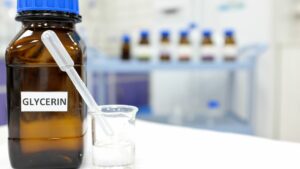Hyaluronic Acid & Co. – Moisturizing For The Body

Moisturizing for the Body – Itching, feelings of tension, redness: Dry skin can have a serious impact on your well-being. But it’s not that difficult to help it feel more moisturized with the help of the right products. Suitable moisturizing care for the body can make the skin soft and supple again at any age.
Table of content
- Moisturizing for the body: why is it so important?
- How does a lack of moisture manifest itself in the skin?
- Body lotion, body milk, body butter: How do the various products for moisturizing the body differ?
- Hyaluron, glycerin & Co.: an overview of moisturizing care substances
- Daily care routine: What does a good moisturizer for the body look like?
- Conclusion: Moisturizing care for the body is essential!
Moisturizing for the body: why is it so important?
Depending on age and gender, 60 to 80 percent of our body consists of water – and around a third of this is stored in the skin. To ensure that the skin’s moisture reservoirs are always well filled, it interacts closely with the environment: through evaporation, it releases water into the ambient air, but also absorbs new moisture again.
This is possible due to a complex mixture of metabolic products – the Natural Moisturizing Factor, or NMF for short. The mixture binds moisture in the uppermost layer of the skin and thus plays an outstanding role in maintaining the skin’s balance. As long as this balance is stable, the skin appears plump and fresh. However, there are factors that can promote moisture loss, for example:
- Dry ambient air
- Cold ambient air
- Wind
- UV radiation
A weakened skin protection barrier can also result in more moisture being lost than is absorbed from the ambient air. As a result, the skin gets out of balance and becomes increasingly dry.
How does a lack of moisture in the skin make itself felt?
Dry skin manifests itself in a variety of ways. Typical symptoms are:
- Redness
- Itching
- Tension
- Scaling
When there is a lack of moisture, we literally do not feel comfortable in our skin. If the moisturizing care for the body continues to be lacking, in the worst case, even painful, superficial cracks can develop.
Body lotion, body milk, body butter: How do the various products differ?
The range of moisturizing products for the body is unmanageably large. We would like to shed some light on this and have therefore summarized the most important features of body lotions, body milks and body butters.
Body lotion
- High water content
- Less rich than body milk and body butter
- Light care substances such as: aloe vera, herbal extracts
- Cooling effect due to evaporating water
- Creamy consistency
Body milk
- High fat content
- Intensive care substances, for example jojoba oil, coconut oil
- Very good for skin prone to dryness
- Long-lasting protection against moisture koss
- Creamy consistency
Body butter
- Ideal for very dry skin that itches or is already cracke
- Contains emollient ingredients such as coconut butter, olive oil
- Moisture is bound in the skin for a longer period of time
- Rather firm consistency
Hyaluron, glycerin & co.: moisturizing care substances at a glance
Some active ingredients to moisturize the body have proven their worth in moisturizing the body and can therefore be found in numerous care products.
Hyaluronic acid
Hyaluronic acid is particularly popular because it is very effective and well tolerated. It is a gel-like, transparent substance that occurs naturally in the body. Around half of the body’s own hyaluronic acid is found in the skin, while the other half is distributed among the joints and eyeballs, among other places.
Hyaluronic acid is also called a moisture magnet because it can bind enormous amounts of water, much like a sponge. With the right moisturizing care for the body, hyaluronic acid can also be supplied to the skin from the outside to keep it smooth and supple.
Glycerin
Glycerin is a natural component of the Natural Moisturizing Factor and helps to ensure that the moisture supplied via skin care is better locked into the skin. It therefore no longer evaporates so easily, leaving the skin beautifully plump and soft.
Ceramides
Ceramides are skin’s own fats that are found in the skin’s natural protective barrier. If the skin lacks ceramides, moisture is lost more easily. A moisturizer for the body that also contains ceramides in the list of ingredients is therefore a good choice.
Tägliche PflegeDaily care routine: What does a good moisturizer for the body look like?
The best time to apply a moisturizer for the body is after showering or bathing, because any contact with water extracts moisture from the skin – this effect is stronger the hotter the water is. Therefore, it is recommended to prefer rather moderate temperatures when showering or bathing.
How often the moisturizer for the body should be applied depends on the individual needs of the skin. Once a day is usually sufficient. However, especially in winter, when the skin is stressed by wind, cold, thick clothing and dry heating air, it can be useful to pamper the body with an additional moisturizer in between.
Conclusion: Moisturizing for the body is essential!
Anyone who wants to enjoy soft and supple skin day after day pays attention to good moisturizing care for the body. It is important to adapt the care individually to the needs of the skin and to rely on active ingredients that keep the moisture balance of the skin in a healthy balance.
care for the body, moisturizing

Autorin aus München
Eveline Misini ist seit 2017 leidenschaftliche Online-Redakteurin bei rankeffect, einer Online Marketing Firma aus München. Sie schreibt Glossar- und Blogbeiträge für verschiedene Branchen. Zu ihren Kunden zählen unter anderem Schönheitskliniken und Kosmetikhersteller, sodass sie sich im Bereich Beauty – vor allem in der Gesichtspflege – ein breites Wissen angeeignet hat, das sie gerne mit ihrer Leserschaft teilt.



